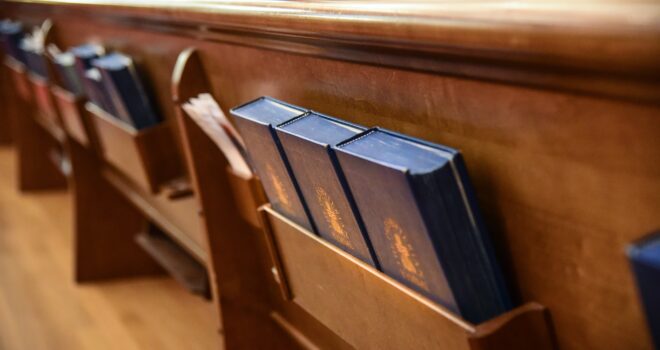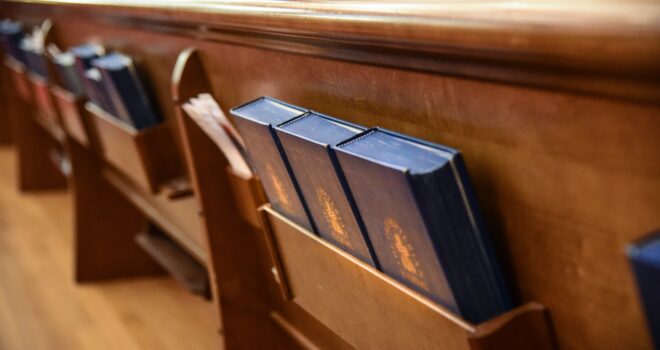As one who has served as a pastoral musician on the parish level for many years, I am often asked, “What is your favorite hymn for Mass?” This is sort of like asking, “What is your favorite college football team?” Or, “What is your favorite ice cream flavor?” Whatever answer you give, you will likely receive reactions of either delight or disdain.
The better question for liturgical preferences should always be, “What does the Church say is the ideal ____ for Mass?” The ideal vessels for Mass are those made of unbreakable precious metals. The ideal vestments to be worn by the presider are those that coincide with the liturgical color of the year. The ideal person to distribute Holy Communion (under ordinary circumstances) is the ordinary minister: bishop, priest, deacon. The Church stipulates the ideals for all areas of worship, including music. We can simplify these musical ideals by asking two questions: (1) When? and (2) How?
The first question to consider is: When should we sing at Mass? The Church provides for us a specific ‘hierarchy of music.’ This hierarchy exists within three degrees of music, as stipulated in Musicam Sacram (MS), and the General Instruction of the Roman Missal (GIRM).
- The first degree of music should ideally be sung before all other singing; it is the highest degree. This is the Order of the Mass. This singing exists as a dialogue between the priest and the assembly. (“The Lord be with you. R/. And with your spirit.”)
- Once this is fulfilled, the second degree of music may be utilized: the Ordinary of the Mass. These are the parts of the Mass with unchanging texts: Kyrie, Gloria, Sanctus, Agnus Dei, etc. In addition to the vernacular, the church stipulates that the assembly should also be able to “sing in Latin these parts of the Mass which are appropriately theirs.” (Sacrosanctum Concilium [SC], 54)
- After these first two degrees are fulfilled, the third degree should be observed: the Propers of the Mass. These occasions of singing occur at every Mass, though the texts change: The Response Psalm; the Gospel Acclamation verse; the Entrance and Communion antiphons.
Notice that there is no mention of hymns! Perhaps we could be so bold as to qualify hymns within a suggested fourth degree of music. I have found that music directors are trained to up-end these degrees in the opposite direction: What hymns are we going to sing at Mass? (and then…) What Response Psalm setting are we going to sing? (and then…) What Mass setting are we going to use? (and then…) Do we have a priest who sings?
The next suitable question is: How should we sing at Mass? (A quick distinction: If the Church had Her druthers, She would prefer that we not merely ‘sing at Mass,’ but that we sing the Mass. The entire Mass is like a song from Jesus Christ to His Heavenly Father. Virtually everything should be sung within the Mass. If you want an actively participating singing assembly, don’t merely sing at Mass – Sing the Mass!)
As to the manner in which we sing the Mass, the Second Vatican Council affirms the primary “style” of liturgical music as Gregorian chant, which “should be given a place of primacy in liturgical activity.” (SC, 116) The Council also stipulates that the primary instrument for leading music is the pipe organ: “The pipe organ should be held in great honor.” (SC, 120) The Council lists a very close second “style” of music: Sacred polyphony, which is to “by no means be excluded from liturgical celebrations.” (SC, 116) Sacred polyphony is typically executed by a choir or schola. This might seem like an attempt to exclude the assembly from actively participating within the Mass. In fact, there can be a suitable time for the assembly to listen attentively, as “this [active] participation should be above all internal.”… “The faithful should be taught to unite themselves interiorly to what the ministers or choir sing, so that by listening to them they may raise their minds to God.” (MS, 15)
What of the hymns? With all due respect to composers who write hymns with music and lyrics by ___ composer, the Council gives preference to “[hymn texts that] draw principally on scripture and on sources from within the liturgy” (SC, 121). This would certainly not exclude new compositions with original texts, however these texts should be rigorously considered to ensure an erudite transmission of the faith.
What makes a ‘good’ sacred music composition? The United States Conference of Catholic Bishops gives some insight to this question within the 2007 document Sing to the Lord: Music in Divine Worship (STTL). The document lays out three judgements for new liturgical music: (1) Liturgical; (2) Pastoral; (3) Musical. Under the ‘Musical’ category, the bishops warn about cliché popular music within the Mass:
“To admit to the Liturgy the cheap, the trite, or the musical cliché often found in secular popular songs is to cheapen the Liturgy, to expose it to ridicule, and to invite failure.” (STTL, 135)
Musicians reading these words may be able to quickly think of ‘cheap’ and ‘trite’ clichés that are often found in pop songs. Are these clichés in the songs we sing at Mass? We will not take up the specifics here, but this warning from the bishops is worth contemplating.
The “failure” of pop music within the liturgy is the overly sentimental nature that it can sometimes force upon the adorers in the pews. Sunday worshippers don’t need a ‘pat on the head’ through sappy songs. The emotional response of the faithful should come about naturally through an encounter with the Risen Lord who is re-presented on the Altar as the One, perfect Sacrifice once for all. Sentimental music can often feel coercive; as if we are expecting the folks in the pews to ‘blossom’ at a specific moment within the Mass. Catholic author Flannery O’Connor speaks about the traps of sentimentalism:
“We lost our innocence in the fall of our first parents, and our return to it is through the redemption which was brought about by Christ’s death and by our slow participation in it. Sentimentality is a skipping of this process in its concrete reality and an early arrival at a mock state of innocence, which strongly suggests its opposite.”
The death of Jesus Christ restores humanity to the Garden of Paradise that was lost, and we all can become at-one with Him in Heaven. To pretend that we’re already there is to enter this ‘mock state’ of innocence and skip the race that we are running. Over the last several decades, the confession lines have dwindled, yet the Communion lines are full. The message of sentimentalism skips the confession line. Liturgy and music should not merely affirm where we are. Rather, it should move us toward conversion and to the ultimate goal of heaven.
What is my favorite hymn? It’s the one that moves me toward reconciliation with God. It’s one that begs for re-conversion. It’s the one that changes me. After all, God loves us all just the way we are, but He loves us too much to let us stay that way.












